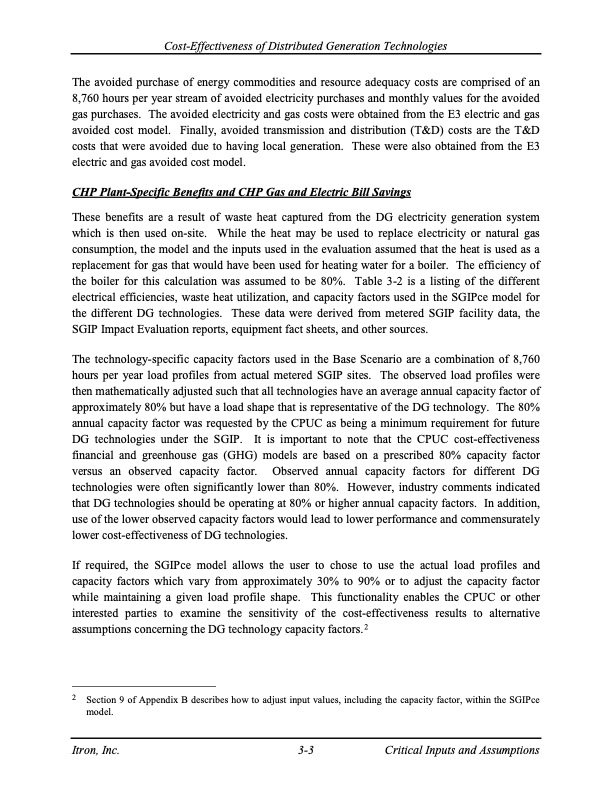
PDF Publication Title:
Text from PDF Page: 032
Cost-Effectiveness of Distributed Generation Technologies The avoided purchase of energy commodities and resource adequacy costs are comprised of an 8,760 hours per year stream of avoided electricity purchases and monthly values for the avoided gas purchases. The avoided electricity and gas costs were obtained from the E3 electric and gas avoided cost model. Finally, avoided transmission and distribution (T&D) costs are the T&D costs that were avoided due to having local generation. These were also obtained from the E3 electric and gas avoided cost model. CHP Plant-Specific Benefits and CHP Gas and Electric Bill Savings These benefits are a result of waste heat captured from the DG electricity generation system which is then used on-site. While the heat may be used to replace electricity or natural gas consumption, the model and the inputs used in the evaluation assumed that the heat is used as a replacement for gas that would have been used for heating water for a boiler. The efficiency of the boiler for this calculation was assumed to be 80%. Table 3-2 is a listing of the different electrical efficiencies, waste heat utilization, and capacity factors used in the SGIPce model for the different DG technologies. These data were derived from metered SGIP facility data, the SGIP Impact Evaluation reports, equipment fact sheets, and other sources. The technology-specific capacity factors used in the Base Scenario are a combination of 8,760 hours per year load profiles from actual metered SGIP sites. The observed load profiles were then mathematically adjusted such that all technologies have an average annual capacity factor of approximately 80% but have a load shape that is representative of the DG technology. The 80% annual capacity factor was requested by the CPUC as being a minimum requirement for future DG technologies under the SGIP. It is important to note that the CPUC cost-effectiveness financial and greenhouse gas (GHG) models are based on a prescribed 80% capacity factor versus an observed capacity factor. Observed annual capacity factors for different DG technologies were often significantly lower than 80%. However, industry comments indicated that DG technologies should be operating at 80% or higher annual capacity factors. In addition, use of the lower observed capacity factors would lead to lower performance and commensurately lower cost-effectiveness of DG technologies. If required, the SGIPce model allows the user to chose to use the actual load profiles and capacity factors which vary from approximately 30% to 90% or to adjust the capacity factor while maintaining a given load profile shape. This functionality enables the CPUC or other interested parties to examine the sensitivity of the cost-effectiveness results to alternative assumptions concerning the DG technology capacity factors.2 2 model. Section 9 of Appendix B describes how to adjust input values, including the capacity factor, within the SGIPce Itron, Inc. 3-3 Critical Inputs and AssumptionsPDF Image | Cost-Effectiveness of Distributed Generation Technologies

PDF Search Title:
Cost-Effectiveness of Distributed Generation TechnologiesOriginal File Name Searched:
SGIP_CE_Report_Final.pdfDIY PDF Search: Google It | Yahoo | Bing
NFT (Non Fungible Token): Buy our tech, design, development or system NFT and become part of our tech NFT network... More Info
IT XR Project Redstone NFT Available for Sale: NFT for high tech turbine design with one part 3D printed counter-rotating energy turbine. Be part of the future with this NFT. Can be bought and sold but only one design NFT exists. Royalties go to the developer (Infinity) to keep enhancing design and applications... More Info
Infinity Turbine IT XR Project Redstone Design: NFT for sale... NFT for high tech turbine design with one part 3D printed counter-rotating energy turbine. Includes all rights to this turbine design, including license for Fluid Handling Block I and II for the turbine assembly and housing. The NFT includes the blueprints (cad/cam), revenue streams, and all future development of the IT XR Project Redstone... More Info
Infinity Turbine ROT Radial Outflow Turbine 24 Design and Worldwide Rights: NFT for sale... NFT for the ROT 24 energy turbine. Be part of the future with this NFT. This design can be bought and sold but only one design NFT exists. You may manufacture the unit, or get the revenues from its sale from Infinity Turbine. Royalties go to the developer (Infinity) to keep enhancing design and applications... More Info
Infinity Supercritical CO2 10 Liter Extractor Design and Worldwide Rights: The Infinity Supercritical 10L CO2 extractor is for botanical oil extraction, which is rich in terpenes and can produce shelf ready full spectrum oil. With over 5 years of development, this industry leader mature extractor machine has been sold since 2015 and is part of many profitable businesses. The process can also be used for electrowinning, e-waste recycling, and lithium battery recycling, gold mining electronic wastes, precious metals. CO2 can also be used in a reverse fuel cell with nafion to make a gas-to-liquids fuel, such as methanol, ethanol and butanol or ethylene. Supercritical CO2 has also been used for treating nafion to make it more effective catalyst. This NFT is for the purchase of worldwide rights which includes the design. More Info
NFT (Non Fungible Token): Buy our tech, design, development or system NFT and become part of our tech NFT network... More Info
Infinity Turbine Products: Special for this month, any plans are $10,000 for complete Cad/Cam blueprints. License is for one build. Try before you buy a production license. May pay by Bitcoin or other Crypto. Products Page... More Info
| CONTACT TEL: 608-238-6001 Email: greg@infinityturbine.com | RSS | AMP |